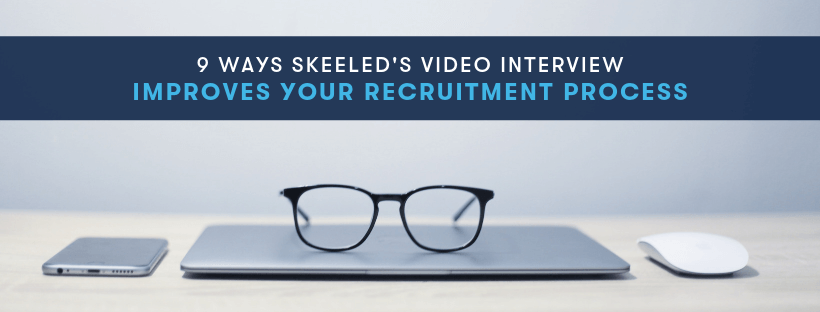Seeking new talent is an ever-growing challenge for companies. It’s not new that the shortage of skills in the job market increases the competition and the need to attract, engage and recruit the best candidates faster.
As a CEO you are certainly aware that a more efficient hiring process that provides a better candidate experience is key to your company hold on to the best candidates and prevent the costs of bad hires (Careerbuilder).
However, developing and managing a great recruiting process can be rather difficult without the right strategy. You don’t want to just speed up your recruitment cycle to the point of missing important steps that are necessary to identify the most qualified candidates on your talent pool.
On the other hand, your hiring managers shouldn’t keep using the same old methods as well or you'll keep losing candidates to other companies that have more expedite processes. Today, candidates expect a fast and easy application experience and many are not willing to wait for feedback for more than two weeks of applying (Careerbuilder).
So, how can you make your hiring process easier and faster for both the candidates and the recruiters without compromising the quality of hire? Follow these steps to turn your recruiting process around:
1. Improve Your Job Postings
First of all, you need to make sure your job descriptions are both accurate and attractive. The best way to keep good candidates around is to deliver on their expectations and start with an honest job offer. Check here how to write job descriptions on point.
Another important aspect you need to consider is where your recruiting team is sharing your open positions. Are they advertising your vacacies on the most suited job boards? Is it easy for them to quickly share your jobs on multiple employment websites?
The right recruitment software can help your hiring team distribute your vacancies across various job boards at once, with just a few clicks.
2. Make it Easy to Apply
Candidates aren’t willing to participate in long and exhausting application processes. When it comes to the application forms, they expect you to allow them to fill it out on their mobile phones. And they’re counting on you to parse their resumes and limit the remaining fields to relevant, application related information that is not on their CVs.
According to Careerbuilder, 20 percent of candidates drop out of application forms that take longer than 10 minutes to fill.
Are you confident your application process is meets these expectations? Again, using the right recruitment software can help you deliver an optimised, mobile-friendly application process that allows candidates to apply faster.
3. Improve Candidate Sourcing
In addition to job boards and your career page, social media channels are also great to source candidates. Make sure your recruiting team leverages the power of social recruiting.
Another great way of sourcing candidates is going through your candidates’ database. Use your recruitment software to search for qualified candidates that you didn’t hire in the past and are suited for a new position.
Also, leverage your employees’ professional network by allowing referrals. This a very cost-effective way of engaging with top, passive candidates.
4. Leverage AI-Powered Candidate Screening
One of the most important steps in the hiring process, candidate screening allows recruiters to dismiss candidates that are unsuitable for a position and to focus on those that best match the requirements.
However, this is one of the hardest and time-consuming manual tasks that a recruiter can perform. Given the average number of applications per position, it's humanly impossible for your recruiting team to screen every candidate accurately and ensure that the best candidates are all kept in the process.
AI-based automation of the screening process is the best solution. The right applicant tracking system can provide you an automated selection of candidates based on the job requirements set by your recruiting team. This feature speeds up your recruiting process without compromising the screening quality.
On the contrary, the algorithm that screens candidates doesn't get tired of looking at CVs and it doesn't rely on the unconscious bias we humans do.
5. Use New Ways of Assessing Candidates
One-way video interviews are a great way of making sure you only invite the most suited candidates to meet in person. How many times did you or your team find yourselves thinking that you were wasting your time with a candidate that wasn’t a good fit after only 5 minutes in the interview?
By including a pre-recorded video interview step on your application process you have the chance to look at candidates and assess their fitness for the position, before inviting them to a face-to-face interview. All your team needs to do is to define a set of questions they would like the candidates to answer and then review the answers.
Testing candidates’ personalities is also an important selection step, given that it allows to predict future job performance accurately and make evidence-based recruiting decisions. Curious about how you can better assess candidates with a personality test? Read all about it here.
Both these tools can speed up your hiring process by providing recruiters with important data to improve the initial screening of candidates and helping them decide who should move on to the next stages of the recruitment.
6. Use Structured Interview Questions
Interviewing candidates gives the recruiter the opportunity to further assess their motivations towards the position and the company as well as their skills and cultural fit.
However, interviews can turn into a big waste of time if you’re not doing it right. And by that we mean if you’re not following a structured interview process.
Unstructured interviews can only explain 14 percent of an employee’s performance. While structured interviews can predict employee’s performance by 26%. Moreover, in a structured interview, all candidates are asked the same consistent set of questions and there is clear criteria to assess the quality of their responses.
Structured interviews allow to evaluate candidates equally against the required and desired criteria. Obviously this requires that every candidate get’s asked that same set of questions and is given the same assessment, so recruiters must stick to the script.
7. Improve Candidate Engagement
Keeping candidates engaged throughout the hiring process is vital to your hiring process efficiency. Candidates that don’t hear from you, simply walk away.
Plan your recruitment’s process touchpoints and leverage recruitment software tools like email automation to make sure you keep candidates in the loop regarding where they stand in the process and provide them a winning candidate experience. Create mass, personalised email templates where you detail their application status and let them know about the next steps. With just a few clicks your recruiters can keep every single candidate updated and prevent them from dropping out due to lack of communication.
Keep your hiring process updated with these 7 steps and make sure your recruiting team succeeds in attracting, engaging and hiring the best people.

Skeeled offers you the perfect opportunity to bring innovation and digitalisation to your hiring. Check our website or our LinkedIn, Twitter and Facebook pages for further information.
Thanks for reading and see you next time!
Your team here at skeeled





